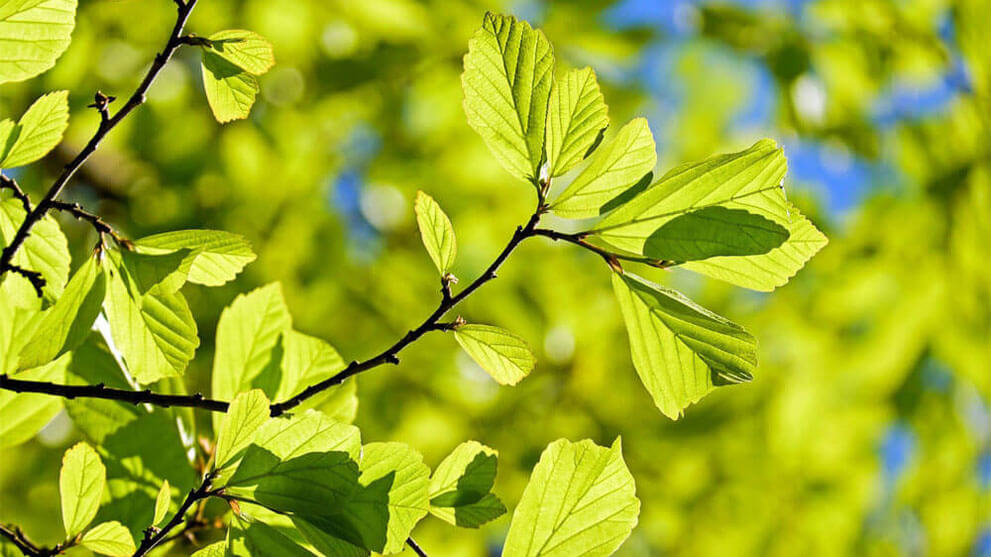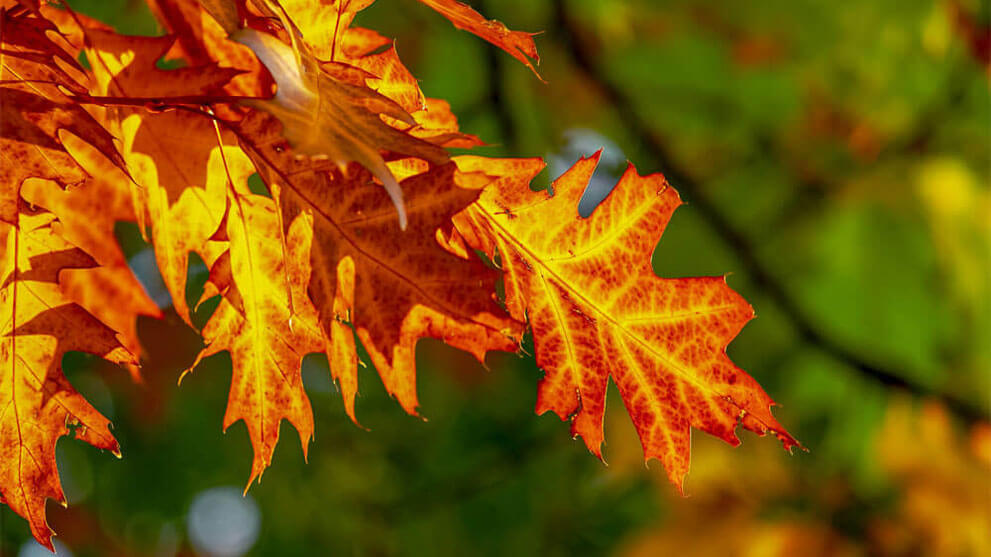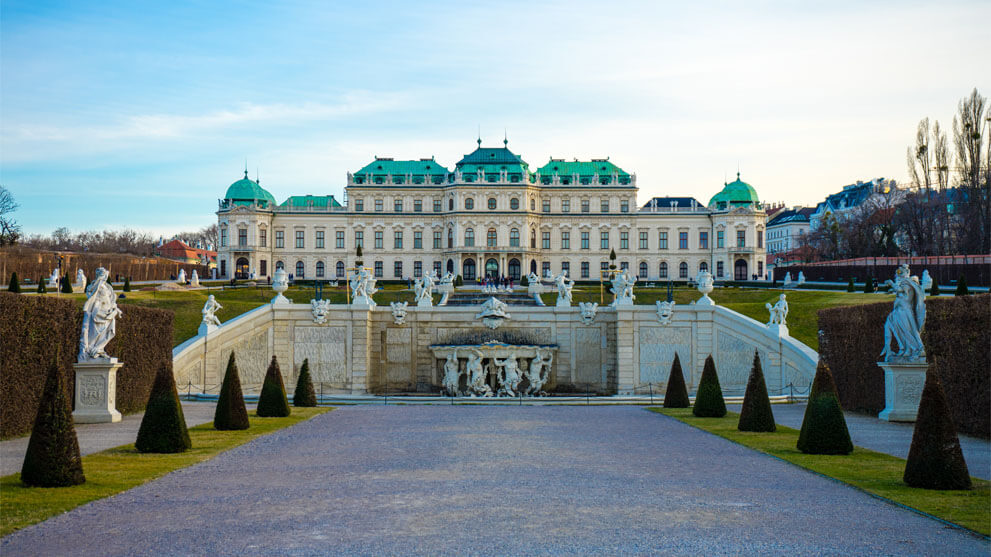Typical Viennese breakfast
A typical Viennese breakfast includes coffee, a roll, a crescent-shaped croissant, butter, jam and a soft-boiled egg. The absolute classic drink is the Viennese mélange.

In our Vienna city guide, you will find all the essential information you need for a successful visit to the Austrian capital.
Anyone visiting Vienna should definitely make a detour to savour its culinary delights. The city is not only known for its variety of coffee houses, but also for delicacies such as apple strudel, Sachertorte and Wiener Schnitzel. Viennese cuisine is a mixture of Austrian specialities and those of the former countries of the Austro-Hungarian monarchy.
Lunch menus are offered in many restaurants in Vienna. They are usually very reasonably priced and invite you on a culinary excursion into Viennese cuisine.
A typical Viennese breakfast includes coffee, a roll, a crescent-shaped croissant, butter, jam and a soft-boiled egg. The absolute classic drink is the Viennese mélange.
Viennese cuisine is rich in soups. The particularly well-known and popular goulash soup even helps to overcome hunger pangs. Other typical Viennese soups are fritattensuppe or semolina dumpling soup.
Probably the most famous main course is the Wiener Schnitzel with potato salad. A slice of lemon or cranberries are also a must. Other typical main courses include boiled beef, goulash or roast pork with sauerkraut and dumplings.
Pastries such as apple strudel, Linzer or Sacher cake are served as a dessert. Others, such as Kaiserschmarrn, can also be served as a main meal. Faschingskrapfen or Topfengolatschen are eaten in Vienna for breakfast or in between meals.
There is a large selection of beers as well as red and white wines. In summer, people in Vienna like to drink a Gspritzten - an eight-litre glass of white wine with an eight-litre glass of soda water. A little tip for beer drinkers: if you want to order the small beer (0.3 litres) in Viennese, ask for a "Seiterl".
A coffee house is the ideal opportunity to get to know the authentic Viennese coffee house culture. It's about more than just coffee. Discover the old Viennese world of Melange, Buchteln and living history.
Vienna has an incredible amount to offer at any time of year and is always worth a visit. The different seasons have their very own flair and cover the capital with their colours.

In Vienna, spring usually begins in March and is one of the most beautiful seasons for many. The blossoming trees and flowers bathe the many parks in a sea of colour and the first coffee houses open their terraces.
May also sees the sensational Life Ball fashion show on Vienna's Rathausplatz. Alongside the Opera Ball, the Life Ball is Vienna's biggest social highlight and attracts international stars to the Austrian capital every year.

In summer, temperatures often reach 30 degrees or more. People relax in parks, on the lawns of the countless outdoor swimming pools or on the Danube Island.
The range of leisure activities and water sports on offer is also enormous. In the evening, you can visit a pub garden or a wine tavern.
Vienna also attracts visitors in summer with its many cultural events and festivals. The largest open-air festival in Central Europe takes place on the Danube Island.

Temperatures vary greatly in autumn, but the wind makes the temperatures seem cooler than they actually are. Visits to coffee houses are particularly tempting in autumn.
In autumn, Vienna also spoils its residents and visitors with plenty of culture. On the Austrian National Day, 26 October, admission to many museums is free.
An absolute autumn highlight is the Viennale international film festival in October. If you want, you can go to the cinema all day until late into the night. The first cinema events take place in the morning, the last after midnight.

The coldest months are December and January. Snow, ice and sub-zero temperatures are not uncommon. In addition to the huge cultural programme, there are other leisure activities on offer during the cold season.
The countless Christmas markets open at the beginning of Advent. The most beautiful are located on Rathausplatz, on Spittelberg and at Schönbrunn Palace.
January is ball season in Vienna. Balls such as the Viennese Coffee Brewers' Ball take place in the Vienna Hofburg. The most famous ball in the world is the Vienna Opera Ball at the Vienna State Opera, opposite the DeutschAkademie.
Another winter highlight are the ice skating rinks in Vienna.

Within the European Union, Vienna is the city with the highest quality of life. In the global city ranking, Vienna is in 3rd place.
More than 50 criteria were taken into account for the city ranking. Political stability, security, medical care, leisure and entertainment facilities, catering, schools, education, culture, transport, the environment and, last but not least, the cost of living were compared.

The Viennese are aware of the high quality of life in their city. What they particularly appreciate about it are the many parks in the city and its proximity to the countryside. Vienna is a very green city thanks to its many spacious parks and gardens. Those who love excursions can leave the big city behind them in no time at all. From the city centre, you can be in the middle of the countryside in 20 minutes.
A "hot" tip for nightlife in Vienna is the Gürtelmeile. From the "Josefstädter Straße" underground station, one pub follows the next. At weekends, you can even go out here until the early hours of the morning.
Recommended clubs include the U 4 in Vienna's twelfth district, Flex on the Danube Canal between Vienna's first and second districts, the Jenseits dance café on Nelkengasse in Vienna's seventh district and the pubs in Volksgarten in Vienna's first district.
Most pubs close at 2am. The pubs on the Gürtelmeile are open longer and most of them close at 4am.
If you are interested in music, then Vienna is the right city to learn German and enjoy classical music at the same time. But rock and pop lovers will also get their money's worth alongside their German course.
The Danube Island Festival is the largest open-air festival in Central Europe and takes place every year in the second half of June. The musical spectrum is as broad as the music itself. In addition to international rock and pop stars, Austrian artists also perform on the Danube Island. Admission is free.
Some of the greatest musical personalities in history have lived and worked in Vienna. Because of the importance of these musicians, the tradition is particularly cultivated in Vienna through regular concerts and festivals. The concerts and festivals for classical and new music usually take place in the Musikverein or the Konzerthaus.
However, Vienna is also the capital of the waltz. The Vienna Philharmonic's New Year's Concert is the most famous classical concert in the world. It takes place every New Year at the Musikverein and always ends traditionally: with the Danube Waltz by Johann Strauss Sohn.
The opening of an exhibition is known as a vernissage and admission to vernissages is free of charge. Occasionally, drinks and food are also offered free of charge.
Vienna has a large selection of museums and galleries. In addition to visiting established sites such as the Kunsthaus Wien, the newly opened Albertina and the Museum of Applied Arts (MAK), a visit to the Museumsquartier is a must for art-loving visitors to Vienna.
The Museumsquartier is one of the largest museum districts in Europe. The former imperial and royal stables are home to the Museum Ludwig, the Leopold Foundation, the Kunsthalle, the Zoom children's museum, the Architekturzentrum Wien and the quartier 21, a platform for contemporary art. Directly opposite are the Kunsthistorisches Museum and the Naturhistorisches Museum.
Artists from Vienna have repeatedly produced new art movements. The best known of these are the Vienna Secession and Viennese Actionism.
The Vienna Secession was founded in 1897 as a protest against the prevailing way of thinking about art and under the leadership of the famous Austrian draughtsman, graphic artist and painter Gustav Klimt.
Viennese Actionism was a movement between 1960 and 1970 that endeavoured to bring about social change. Its most famous representatives include Hermann Nitsch and Otto Mühl.
A visit to the theatre doesn't have to be expensive. In renowned theatres such as the Burgtheater or the State Opera, it is often possible to buy cheap remaining tickets or standing room only shortly before the performance begins.
The Burgtheater is the most famous theatre in the German-speaking world. Because the best actors and directors work there, most young actors dream of playing at the Burgtheater in Vienna one day.
The Vienna State Opera is one of the world's leading opera houses and is located directly opposite the DeutschAkademie. Classical ballet and opera performances with artists such as Placido Domingo and José Carreras alongside the Vienna Philharmonic Orchestra contribute greatly to the opera house's excellent reputation.
The fact that Vienna is also a modern cultural metropolis is proven year after year by festivals such as the Wiener Festwochen or ImpulsTanz. Between May and August, the best and most interesting spoken word, dance and music theatre productions from all over the world come to Vienna.
Carol Reed's classic film "The Third Man" is regularly shown at the Burgkino in the original English version with German subtitles. The Burgkino cinema is a two-minute walk from the DeutschAkademie Wien.
Vienna had a flourishing film industry in the 1930s, 1940s and 1950s. The music, Heimat and k.u.k. films of that time may be ridiculed today, but they are still famous.
The film industry came to a standstill at the end of the 1960s, but Austrian filmmakers have been attracting more attention again since the beginning of the 1990s.
Vienna has been the location and setting for a number of international film productions. The most famous is Carol Reed's literary adaptation of Graham Greene's "The Third Man".
This film is a classic and is set in famous Viennese locations such as the Central Cemetery, the Hotel Sacher and the Prater.
The quickest and easiest way to get to Vienna is by plane. Vienna-Schwechat Airport is 25 minutes from Vienna city centre - buses, the City Airport Train, the S-Bahn and taxis run from there to the city centre.
If you are travelling to Vienna by train, you will either arrive at Vienna Südbahnhof or Vienna Westbahnhof. Timetables and further information about travelling by train can be found at www.oebb.at.
There are bus connections to Vienna from the following countries: Belgium, Bosnia, Bulgaria, Germany, Denmark, Estonia, France, Holland, Italy, Croatia, Latvia, Lithuania, Macedonia, Poland, Switzerland, Serbia, Slovakia, Slovenia, Czech Republic, Ukraine and Hungary.
Anyone travelling to Vienna by car must pay attention to the short-term parking zone. From Monday to Friday, parking in districts 1 to 9 and 20 between 9 am and 8 pm is subject to a charge. Parking tickets are sold at tobacconists and banks.
The public transport network in Vienna is one of the best in the world. There are five underground lines, 32 tram lines and 80 bus lines - 22 of which are night lines. Waiting times are short. At peak times they are three minutes in the underground stations and five minutes at the bus stops. In the evening, the intervals are between five minutes for the underground and 15 minutes for the tram.
For your information: fare evasion costs 105 euros in Vienna. The ticket inspectors are called Schwarzkappler in Vienna and carry out regular checks.
The first underground trains leave at around five in the morning, the last shortly after midnight. The tram and bus lines start later and stop earlier - exact information can be found in the respective timetables. The night buses run every half hour and at times when there are no underground trains. Click here for the online timetable.
Short distances are often easier to cover by bike. Terminals with rental bikes have therefore been set up around Vienna's city centre. Use of the bikes is free for the first hour. However, registration is necessary. This is done directly at the terminal using a credit card.